Lisaribau
On this page, you find all documents, package deals, and flashcards offered by seller lisaribau.
- 49
- 0
- 5
Community
- Followers
- Following
54 items
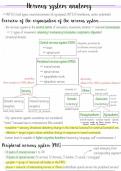
NEU 1: Nervous system anatomy
Lecture notes from Imperial College London, Medical Biosciences BSc, 2nd year, Neuroscience (NEU) module. learning objectives: LO1: Recall the gross organisation of the human central and peripheral nervous systems LO2: Illustrate the structure and functions of the spinal and cranial nerves LO3: Identify the main CNS structures and summarise their functions: spinal cord, brainstem, diencephalon, basal ganglia, cerebral cortex and cerebellum. LO4: Explain the structure and function of: c...
- Package deal
- Class notes
- • 11 pages •
Lecture notes from Imperial College London, Medical Biosciences BSc, 2nd year, Neuroscience (NEU) module. learning objectives: LO1: Recall the gross organisation of the human central and peripheral nervous systems LO2: Illustrate the structure and functions of the spinal and cranial nerves LO3: Identify the main CNS structures and summarise their functions: spinal cord, brainstem, diencephalon, basal ganglia, cerebral cortex and cerebellum. LO4: Explain the structure and function of: c...
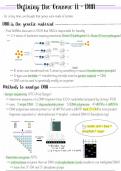
Genetics & Genomics module Imperial College London
Complete and detailed lecture notes about genetics & genomics Course taken at Imperial College London and obtained above 80% using those notes only. Colours, images, drawings, graphs, figures, and tables included.
- Package deal
- • 9 items •
- GEN 10: New and future developments • Class notes
- GEN 5: Mapping the genome • Class notes
- GEN 9: Engineering the genome • Class notes
- GEN 7: Expressing the Genome • Class notes
- GEN 2: Defining the Genome I - Chromosomes • Class notes
- And more ….
Complete and detailed lecture notes about genetics & genomics Course taken at Imperial College London and obtained above 80% using those notes only. Colours, images, drawings, graphs, figures, and tables included.

GEN 8: Protecting the Genome
Lecture notes from Imperial College London, Medical Biosciences BSc, 2nd year, genetics and genomics (GEN) module. Our DNA is under constant threat of being damaged by exogenous and endogenous insults. We have some mechanisms that provide protection from these insults, but there are limits to what they can achieve. In these notes, we consider how DNA damage arises, how it can be avoided, what it actually looks like, and how it is repaired. We also see how mutations in DNA repair genes are ass...
- Class notes
- • 8 pages •
Lecture notes from Imperial College London, Medical Biosciences BSc, 2nd year, genetics and genomics (GEN) module. Our DNA is under constant threat of being damaged by exogenous and endogenous insults. We have some mechanisms that provide protection from these insults, but there are limits to what they can achieve. In these notes, we consider how DNA damage arises, how it can be avoided, what it actually looks like, and how it is repaired. We also see how mutations in DNA repair genes are ass...

GEN 3: Defining the Genome II - DNA
Lecture notes from Imperial College London, Medical Biosciences BSc, 2nd year, genetics and genomics (GEN) module. Focus on genomic DNA. How do we know it is the DNA that genes are made of? In fact, for a long time it was thought that genes must be made of protein. We'll describe how this idea was disproved. Once it was realised that genes were DNA, techniques for analysing DNA burgeoned and gave rise to modern molecular genetics and genomics. We will review the basic principles of some of t...
- Package deal
- Class notes
- • 7 pages •
Lecture notes from Imperial College London, Medical Biosciences BSc, 2nd year, genetics and genomics (GEN) module. Focus on genomic DNA. How do we know it is the DNA that genes are made of? In fact, for a long time it was thought that genes must be made of protein. We'll describe how this idea was disproved. Once it was realised that genes were DNA, techniques for analysing DNA burgeoned and gave rise to modern molecular genetics and genomics. We will review the basic principles of some of t...
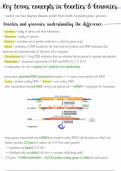
GEN 1: Key terms and concepts in Genetics & Genomics
Lecture notes from Imperial College London, Medical Biosciences BSc, 2nd year, genetics and genomics (GEN) module. What are Genetics and Genomics and why are they so important? As more and more was learned about genes, and the chromosomes that carry them, the importance of genomes emerged. Genomics allows us to study how all this genetic material works together to underpin complex characteristics. These days the news is full of good and bad stories about the influence of Genetics and Genomics...
- Package deal
- Class notes
- • 5 pages •
Lecture notes from Imperial College London, Medical Biosciences BSc, 2nd year, genetics and genomics (GEN) module. What are Genetics and Genomics and why are they so important? As more and more was learned about genes, and the chromosomes that carry them, the importance of genomes emerged. Genomics allows us to study how all this genetic material works together to underpin complex characteristics. These days the news is full of good and bad stories about the influence of Genetics and Genomics...

GEN 4: Comparative Genomics
Lecture notes from Imperial College London, Medical Biosciences BSc, 2nd year, genetics and genomics (GEN) module. By comparing the sequences of different species we can identify sequences that have been conserved over long periods of evolution and so are likely to have important biological functions. You will also see how the extent of such sequence conservation can be used to measure evolutionary relationships between the species. Similarly, when comparing sequences repeats within a single ...
- Package deal
- Class notes
- • 3 pages •
Lecture notes from Imperial College London, Medical Biosciences BSc, 2nd year, genetics and genomics (GEN) module. By comparing the sequences of different species we can identify sequences that have been conserved over long periods of evolution and so are likely to have important biological functions. You will also see how the extent of such sequence conservation can be used to measure evolutionary relationships between the species. Similarly, when comparing sequences repeats within a single ...
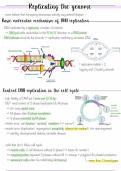
GEN 6: Replicating the Genome
Lecture notes from Imperial College London, Medical Biosciences BSc, 2nd year, genetics and genomics (GEN) module. Focus on replication of the genome. Before a cell divides, the entire genome of 3 billion base pairs must first be copied: accurately, quickly and just once per cell cycle. During this replication, chromosomal DNA must be unwound without getting tangled or suffering breakages and, if damage occurs, it must be repaired. Failure to meet any of these requirements may result in damag...
- Package deal
- Class notes
- • 7 pages •
Lecture notes from Imperial College London, Medical Biosciences BSc, 2nd year, genetics and genomics (GEN) module. Focus on replication of the genome. Before a cell divides, the entire genome of 3 billion base pairs must first be copied: accurately, quickly and just once per cell cycle. During this replication, chromosomal DNA must be unwound without getting tangled or suffering breakages and, if damage occurs, it must be repaired. Failure to meet any of these requirements may result in damag...
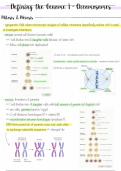
GEN 2: Defining the Genome I - Chromosomes
Lecture notes from Imperial College London, Medical Biosciences BSc, 2nd year, genetics and genomics (GEN) module. Focus on nuclear chromosomes: learn how 2 metres of DNA is somehow packaged into these tiny chromosomes and understand some key features of chromosomes that determine their structure and function. Understand the differences between autosomes, sex chromosomes and mitochondrial chromosomes, and their association with disease. learning objectives: - Recall the changes in numbe...
- Package deal
- Class notes
- • 6 pages •
Lecture notes from Imperial College London, Medical Biosciences BSc, 2nd year, genetics and genomics (GEN) module. Focus on nuclear chromosomes: learn how 2 metres of DNA is somehow packaged into these tiny chromosomes and understand some key features of chromosomes that determine their structure and function. Understand the differences between autosomes, sex chromosomes and mitochondrial chromosomes, and their association with disease. learning objectives: - Recall the changes in numbe...
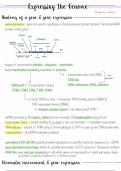
GEN 7: Expressing the Genome
Lecture notes from Imperial College London, Medical Biosciences BSc, 2nd year, genetics and genomics (GEN) module. How is genomic DNA expressed, and how is it that different cell types with the same genome receive different instructions? In these notes, I delve deeper into transcription, and how it is affected by the arrangement of chromatin in the nucleus. I review the process of transcription itself as well as the epigenome - the set of DNA and histone modifications that regulates gene expr...
- Package deal
- Class notes
- • 6 pages •
Lecture notes from Imperial College London, Medical Biosciences BSc, 2nd year, genetics and genomics (GEN) module. How is genomic DNA expressed, and how is it that different cell types with the same genome receive different instructions? In these notes, I delve deeper into transcription, and how it is affected by the arrangement of chromatin in the nucleus. I review the process of transcription itself as well as the epigenome - the set of DNA and histone modifications that regulates gene expr...
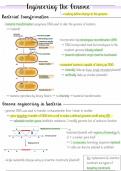
GEN 9: Engineering the genome
Lecture notes from Imperial College London, Medical Biosciences BSc, 2nd year, genetics and genomics (GEN) module. Description of genome engineering methods, particularly in mammals, and the principles underlying them. Nowadays, we can now modify genotypes of most organisms directly, quickly and radically, using a growing array of genome engineering methods. Most of these involve introducing DNA into cells where it integrates into the genome using DNA repair pathways. The latest methods also ...
- Package deal
- Class notes
- • 6 pages •
Lecture notes from Imperial College London, Medical Biosciences BSc, 2nd year, genetics and genomics (GEN) module. Description of genome engineering methods, particularly in mammals, and the principles underlying them. Nowadays, we can now modify genotypes of most organisms directly, quickly and radically, using a growing array of genome engineering methods. Most of these involve introducing DNA into cells where it integrates into the genome using DNA repair pathways. The latest methods also ...
